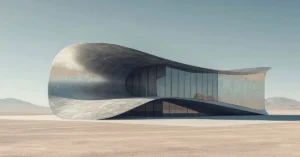From Ancient Wonders to Modern Marvels: Architecture is a discipline that has shaped the world we live in, defining the physical landscapes and the spaces where we work, live, and play. It’s a creative expression that combines art and science, blending form and function to create structures that are not just utilitarian but also aesthetically pleasing. In this blog, we’ll take a bird’s eye view of architecture, journeying through time to explore how it has evolved, from the ancient wonders to the modern marvels that define our contemporary world.
A Bird’s Eye View of Architecture: From Ancient Wonders to Modern Marvels

1. The Foundations of Architecture
To understand the significance of architecture, one must look back to its roots. The origins of architecture can be traced to the dawn of civilization. The first architectural creations were born out of necessity – shelters, temples, and fortifications designed to protect and serve the needs of early human societies.
1.1 Ancient Wonders
The Pyramids of Giza, built over 4,000 years ago, are among the most iconic architectural achievements in human history. These monumental structures, constructed with incredible precision, continue to astound us with their engineering and design. The ancient Egyptians’ mastery of architecture allowed them to create grand tombs for their pharaohs, reflecting a deep understanding of mathematics, astronomy, and art.
Moving east to Asia, the Great Wall of China stands as a testament to the power of architecture to shape the world. This colossal structure stretches over 13,000 miles and showcases the architectural prowess of ancient China, serving both as a defensive fortification and a symbol of unity.
Ancient Greece, with its iconic columns and temples, laid the foundation for classical architecture. The Parthenon in Athens remains a model of harmony, proportion, and aesthetics, embodying the Greek pursuit of architectural perfection.
1.2 Medieval Marvels
The Middle Ages witnessed the construction of breathtaking cathedrals and castles, many of which still stand today. Gothic cathedrals like Chartres Cathedral in France showcased innovations in structural engineering and intricate stained glass work, while medieval castles, like the Mont Saint-Michel in France, blended form and function to provide both defense and aesthetic beauty.
2. The Renaissance and Beyond
The Renaissance period ushered in a renewed interest in the classical architectural principles of Greece and Rome. Architects like Leonardo da Vinci and Filippo Brunelleschi reintroduced concepts of proportion and perspective, inspiring a new era of design. The result was a shift toward more balanced and harmonious architectural forms.
2.1 Architectural Revolutions
The Industrial Revolution of the 18th and 19th centuries brought dramatic changes to architecture. Innovations in construction materials, such as iron and glass, allowed for the creation of larger and more daring structures. The Crystal Palace, designed by Joseph Paxton for the Great Exhibition in London, symbolizes this era’s architectural achievements. Its vast iron and glass structure was not only a marvel of engineering but also an embodiment of modernity.
2.2 Modernism and Beyond
The 20th century witnessed the rise of modernist architecture, characterized by simplicity, functionality, and the use of new materials like concrete and steel. Visionaries like Le Corbusier and Ludwig Mies van der Rohe embraced a “less is more” philosophy, leading to the development of iconic buildings like the Villa Savoye and the Seagram Building.
The Bird’s Nest stadium in Beijing, designed by Herzog & de Meuron for the 2008 Olympics, represents a more recent architectural milestone. Its unconventional and organic structure pushes the boundaries of design and engineering while harmonizing with the surrounding landscape.
3. Contemporary Architectural Marvels
Today’s architectural landscape is marked by a diverse array of styles and structures, reflecting the fusion of tradition and innovation. Skyscrapers like the Burj Khalifa in Dubai and the Shard in London pierce the sky, pushing the limits of vertical architecture. These giants of steel and glass have reshaped cityscapes and redefine urban living.
Sustainable architecture is also at the forefront of contemporary design. Buildings like the One Bryant Park in New York City, designed by Cook + Fox Architects, showcase the incorporation of environmentally friendly technologies, making them more energy-efficient and ecologically responsible.
3.1 The Future of Architecture
As we look to the future, architecture is set to continue evolving. With rapid technological advancements, we can expect to see even more daring and sustainable designs. 3D printing, artificial intelligence, and renewable energy integration are likely to play pivotal roles in shaping the architecture of tomorrow.
Conclusion
In conclusion, architecture is a timeless art form that reflects the values, aspirations, and capabilities of the societies that create it. From the ancient wonders that still stand as testaments to human ingenuity to the modern marvels that shape our urban landscapes, architecture has come a long way. It’s a constantly evolving field, adapting to the ever-changing needs of humanity while simultaneously pushing the boundaries of design and construction. As we continue to explore new horizons and grapple with global challenges, architecture will remain a driving force in shaping the world around us.
So, whether you’re admiring the Pyramids of Giza, strolling through the streets of Paris, or gazing at the skyline of a modern metropolis, take a moment to appreciate the artistry and engineering that goes into creating the architectural wonders that surround us. After all, architecture is not just about buildings; it’s about the human spirit’s desire to leave a mark on the world, one structure at a time.
For more SketchUp tutorials, head to https://www.sketchupguru.com













